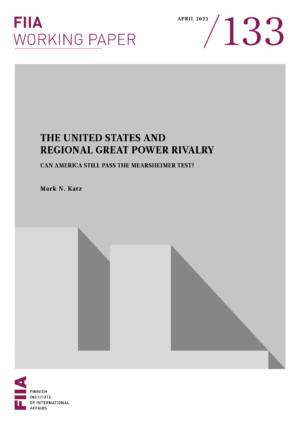FIIA WORKING PAPER 133
 Is a first version of a text that will be developed into a larger publication of an academic or policy-relevant character. The series includes publications aimed at larger audiences as well as expert audiences.
Is a first version of a text that will be developed into a larger publication of an academic or policy-relevant character. The series includes publications aimed at larger audiences as well as expert audiences.The United States is clearly no longer seen as the dominant great power in the world, with great power rivalries and regional powers seeking to expand their influence. But how significant is the much-reported decline in American power, and the rise in that of others? In his book The Tragedy of Great Power Politics, renowned international relations theorist John Mearsheimer set forth a very clear standard for measuring great power influence, namely their influence in the various regions of the world. According to Mearsheimer, the United States is the only country that has achieved predominant influence in its own region (the Western Hemisphere) and has also been able to prevent any other great power from dominating any other region. But is this still true?
Through examining the balance of power in the various regions and subregions of the world, this FIIA Working Paper concludes that the US can still pass “the Mearsheimer test” in all regions of the world, albeit not in all subregions. The paper also points out possible contingencies in which the United States may become less able to pass the Mearsheimer test.
No comments:
Post a Comment